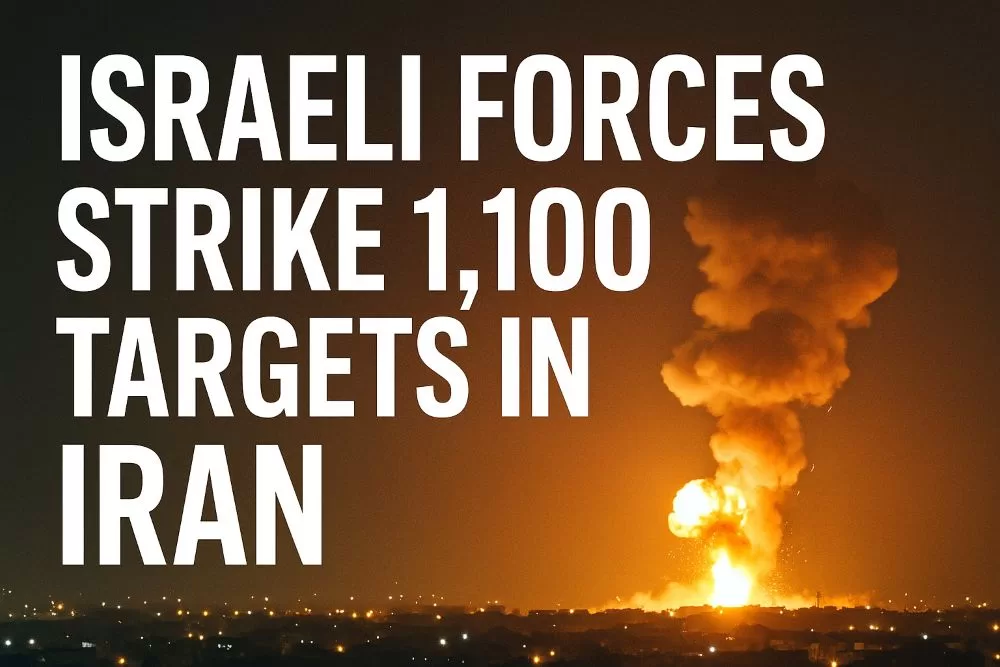
JERUSALEM, June 22 (WSH) — The Israel Defense Forces (IDF) announced that within a five-day period of intensive operations, it launched precision airstrikes on more than 1,100 military targets inside Iran. The targets included centrifuge facilities, missile factories, and key command systems. The IDF claims it now enjoys “unprecedented operational freedom” and has gained partial air superiority over Iranian territory.
Unprecedented Air Campaign Escalates Regional Tensions
Speaking at a press conference in Tel Aviv, IDF spokesperson Effie Defrin emphasized, “This marks Israel’s first large-scale military campaign inside Iranian territory. We are systematically dismantling its nuclear weapons development and military-industrial capabilities.”
The military also released aerial footage of night raids, showing explosions lighting up suspected military compounds south of Tehran.
Defrin revealed that the strikes were initiated before U.S. President Donald Trump ordered a separate surprise attack on Iran’s nuclear facilities on June 19. The U.S. subsequently deployed B-2 Spirit stealth bombers and bunker-busting munitions to coordinate with the Israeli Air Force, creating what Israeli officials called a “multi-axis suppression strategy.”
Israel Claims Breakthrough Against Iranian Air Defenses
Israeli sources insist the campaign has yielded major successes, claiming the Air Force breached Iran’s layered air defense network. High-value targets reportedly hit include a centrifuge plant in Isfahan and a ballistic missile assembly line in Khuzestan.
Meanwhile, the Iranian military claimed it had successfully launched its hypersonic missile “Fattah” in response and allegedly shot down an Israeli fighter jet. However, these claims have not been independently verified.
Background: U.S.-Israel Joint Response to Iran’s Nuclear Escalation
The escalation comes after Iran declared in early June that its stockpile of highly enriched uranium had reached near weapons-grade levels, threatening to break past limits set by the Joint Comprehensive Plan of Action (JCPOA).
Israel responded fiercely, warning that it “would never allow another Holocaust-level threat in the region.” President Trump echoed support via Truth Social, stating that the U.S. “will provide unconditional support to our allies.”
Long-standing Israeli-Iranian hostility has intensified in recent years, with military operations now pushing past former red lines. The involvement of U.S. forces has heightened concerns that the conflict could spiral into a broader regional or even global crisis.
Global Fallout and Future Outlook
The situation remains dangerously volatile. The Iranian parliament has passed emergency legislation preparing for the closure of the Strait of Hormuz, a move that could severely disrupt global energy markets.
The United Nations Security Council is expected to convene an emergency session this week to assess the conflict’s impact on regional stability. China and Russia have called for restraint, while France and Germany have urged a return to diplomacy.
Whether this explosive confrontation evolves into full-scale war remains to be seen — but what is clear is that the geopolitical balance in the Middle East is undergoing a seismic shift.
Background Notes:
- “Operating Freely”: Refers to a military’s ability to conduct operations without significant political restrictions.
- Fattah Missile: Iran’s first hypersonic missile, unveiled in 2023, claimed to be capable of evading all known missile defense systems.
- Strait of Hormuz: A critical chokepoint through which roughly 30% of global seaborne oil passes. Its closure could trigger global energy crises.




